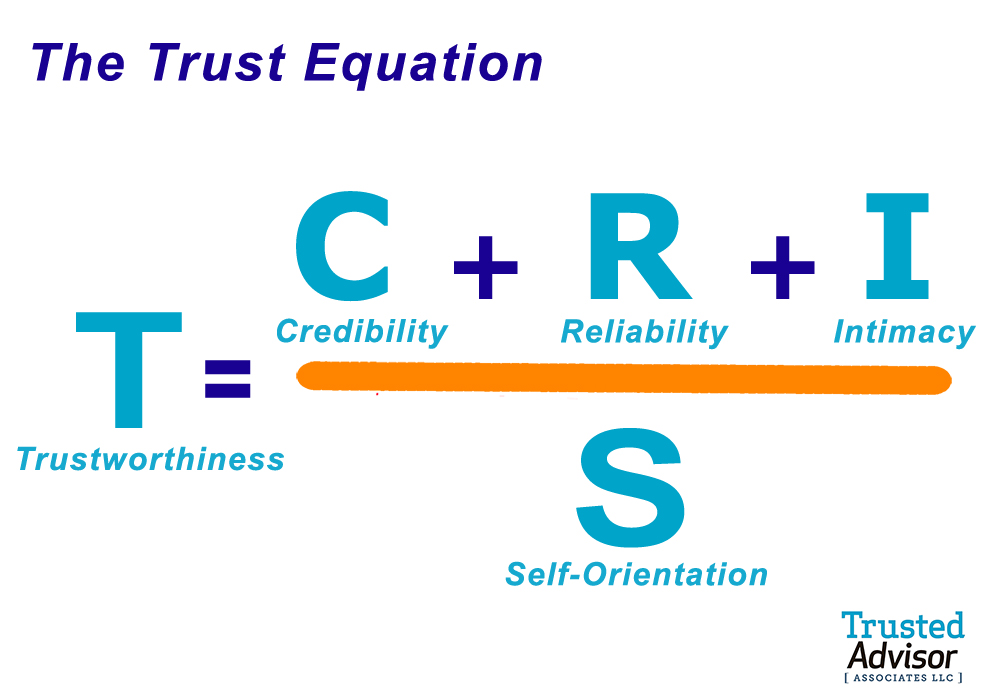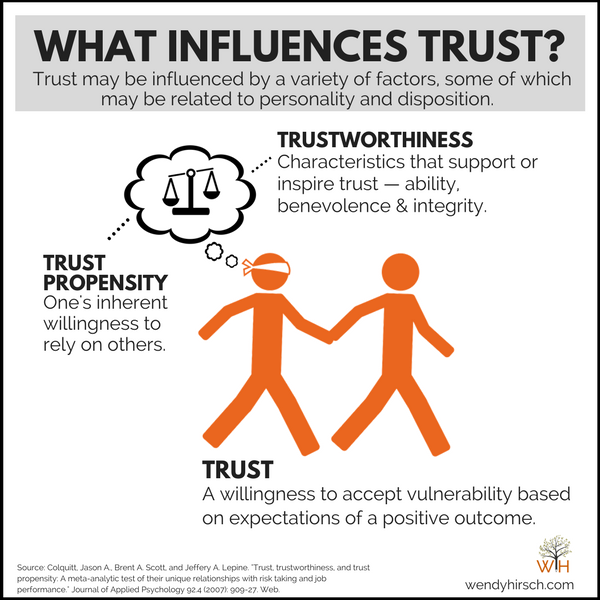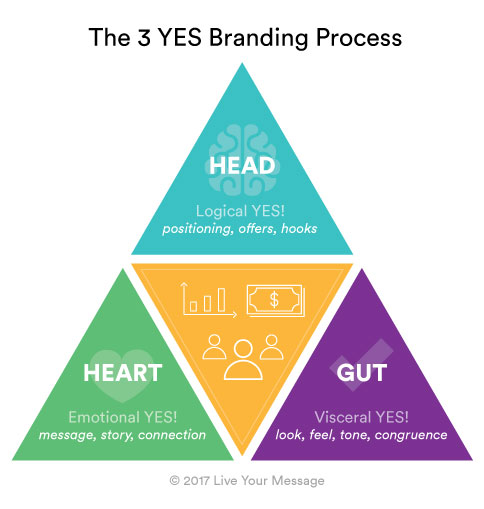Section 1 Kantar Model for Trust
Section 2 Tripod Model for Trust
Section 3 Trust Equation
Section 4 The leader–member exchange (LMX) theory of Trust
Section 5 Blanchard ABCD of Trust
Section 6 Iceberg Model of Trust
Section 7 Wendy Hirsch Model of Trust
Section 8 Covey Matrix Model of Trust
Section 9 Head Heart Gut Model of Trust
I hope I have attributed and named all the models correctly, and I have been careful to include all the links to the resources. I welcome comments or corrections and suggested additions.
Kantar's BrandZ has developed a new model of trust to reflect the drivers of trust among today's consumers. ... Traditionally, consumers trusted well-established brands based on two factors. First is proven expertise, the knowledge that the brand will 'do it well,' reliably and consistently over time.
- Integrity
- Identification
- Inclusion
Comments on this model
It is interesting to think about trust in the context of people, things and concepts. To think about what we would expect from a trustworthy person (eg a good boss or leader) a trustworthy product (eg a good car or watch) a trustworthy concepts (eg a waiting list or test or measure). This model which is about brand uses IDENTIFICATION as a key model of trust (I identify with BMW car or Rolex watch) and also INCLUSION (I am a member of this exclusive club, brand, social set). The INTEGRITY ostensibly appears to be about quality.
However the INCLUSION is always balanced by what is excluded. If you are included then someone somewhere must be excluded for inclusion to have any value or meaning. The IDENTIFICATION is also awkward since not everyone will identify with a person, watch, car or waiting. The INTEGRITY is also subjective because in a brand there is a trade-off between price and quality and there are good functional cars and watches that are not BMW or Rolex just as there are people with integrity who may not be Nelson Mandella or Martin Luther King.
Overall this model of Trust appears to appeal to our sense of self. If it mirrors how we see ourselves then we will trust. If it does not then we will not. So the logic appears to be: If I am part of the gang, and the gang is like me, and consistent with what I value then I will trust.
This logic means some people will trust KKK or Hitler or Communism or Religion whereas others will not. This is perhaps a flawed model and is more like Cult. I suspect there are very close parallels between Cult and Trust.
 Mapping multidimensional models of trust antecedents into the Affective and Cognitive dimensions.
Mapping multidimensional models of trust antecedents into the Affective and Cognitive dimensions.
- Predictability
- Ability
- Benevolence
- Integrity
Comments on this model
This model is interesting the the comparaison and link between COGNITIVE trust and AFFECTIVE trust. This is useful because some people are trusted because of what they say and think and others for their approach and actions. I may trust Nelson Mandella for his words despite no personal experience of his deeds. I may trust by carer for their ability without necessarily talking to them or even understanding them.
The ABILITY to do something BENEVOLENT driven my moral or professional INTEGRITY does seem to be an appealing formula to which many would subscribe or follow. The idea that is reliable, congruent and timely makes it PREDICTABLE and compelling.
 Credibility has to do with the words we speak. In a sentence we might say, “I can trust what she says about intellectual property; she’s very credible on the subject.”
Credibility has to do with the words we speak. In a sentence we might say, “I can trust what she says about intellectual property; she’s very credible on the subject.”
Reliability has to do with actions. We might say, “If he says he’ll deliver the product tomorrow, I trust him, because he’s dependable.”
Intimacy refers to the safety or security that we feel when entrusting someone with something. We might say, “I can trust her with that information; she’s never violated my confidentiality before, and she would never embarrass me.”
Self-orientation refers to the person’s focus. In particular, whether the person’s focus is primarily on him or herself, or on the other person. We might say, “I can’t trust him on this deal — I don’t think he cares enough about me, he’s focused on what he gets out of it.” Or more commonly, “I don’t trust him — I think he’s too concerned about how he’s appearing, so he’s not really paying attention.”
Comments on this model
I do like this model because it acknowledges the observers focus, values, attention and priority. What is in it for me? Or What are the implications for me? Will be a key factor for many people.
 The leader–member exchange (LMX) theory is a relationship-based approach to leadership that focuses on the two-way (dyadic) relationship between leaders and followers.Previous research shows that better LMX results in more resources being available to subordinates and restricted information. Employees in a mobile phone company with better LMX, characterized with a high degree of mutual trust, were more willing to share their knowledge
The leader–member exchange (LMX) theory is a relationship-based approach to leadership that focuses on the two-way (dyadic) relationship between leaders and followers.Previous research shows that better LMX results in more resources being available to subordinates and restricted information. Employees in a mobile phone company with better LMX, characterized with a high degree of mutual trust, were more willing to share their knowledge
Comments on this model
In simple terms the more we work with people and the closer we work with people (both proximity and values) the more we trust them. We tend to put more trust to people we know more and mistrust people we do not really know or have less experience of.
This suggests simply spending time with people will build trust as much as actually doing something. A regular coffee and catch-up may be more powerful than a favour done. If that coffee and catch-up include social chat about common interests that may be more powerful than a decisive action.
This can be so powerful that we trust people we know way beyond what is logical according to their skills, qualification or experience. We may trust a friend to advise on something over which they have no expertise simply because we trust them. This is how tricksters and con-men work and how some top jobs go to people who appear to manifestly unqualified for the role, but nonetheless trusted by the people who put them there: eg electing an actor (Regan) or TV celebrity (Trump )to be President of the USA.

According to Blanchard, there are a number of common elements that decide what trust is. He calls this the ABCD model, in which each letter stands for a word: Ability, Believability, Connectedness and Dependability. Based on these elements, the status of mutual trust in a relationship between people can be determined.
Comments on this model
The ABCD model has the merit of being simple to remember. It does reflect many of the elements already discussed with the other models. I like this because it is practical and transactional: it is instructive of what you can actually do to create trust.
 To explore the idea of trust as an actual but intangible structure, let’s consider the iceberg metaphor. When you look at an iceberg, only the tip is visible; the greater mass lies out of sight below the surface.
To explore the idea of trust as an actual but intangible structure, let’s consider the iceberg metaphor. When you look at an iceberg, only the tip is visible; the greater mass lies out of sight below the surface.
By looking “beneath the surface” of daily events in your organization, you can determine the structures that influence people’s behavior. If we apply this metaphor to understanding trust, the tip is our daily interactions in which we experience varying levels of trust or mistrust (see Peter Senge “The Iceberg Model of Trust” on p. 2).
These interactions, a series of seemingly unrelated events, are the concrete results of an organization’s climate of trust, which exists in the patterns and structures “below the waterline.”
One unpleasant encounter may not lead us to feel an overall sense of mistrust. But if the behavior continues over time, it’s likely to undermine relationships and erode trust throughout the organization. (Note that certain events, such as layoffs, are significant enough to be “trust busters” the first time they occur.)
To determine the degree of trust being transacted during an interaction, you can take the following elements into consideration:
- The history of interactions between individuals and/or groups (What has happened between them in the past?)
- The literal meaning conveyed through the interaction (What words are being expressed?)
- The inferential meaning conveyed through the interaction (What voice tones, facial expressions, and body language are being used?)
- The result of the interaction (Did one party gain an advantage over or “hurt” the other in some manner?)
Comments on this model
Whilst the ABCD model discussed elsewhere is practical, this Iceberg approach is useful since it references the emotional, sub-conscious elements that influence trust, particularly the daily events or lived experience.
The alignment of what we say and what we do, or what people say and what happens is powerful, whether or not there is a direct or causal link. The meaning or sense-making is in the mind of the follower and so trust may be created or broken simply by the sequence of events, how they are interpreted, understood and their relatedness, irrespective of the historical facts.
Spin-doctors and tabloid story tellers use this phenomena to great affect and it is how an emperor may parade with no clothes, but not be naked: Because emotional or sub-conscious needs, belief, hope tells us they must be clothed. We trust them because we need to, we want to, to [have a hero (trust) or villain (mis-trust)]. The trust (or mistrust) is projected onto them rather than earned by them.
 Some researchers differentiate between trust, and the things that may inspire or support it, as follows (Colquitt, 2007) :
Some researchers differentiate between trust, and the things that may inspire or support it, as follows (Colquitt, 2007) :
- Trust: One’s willingness to accept some vulnerability based on expectations of a positive outcome.
- Trust Propensity: One’s general disposition towards relying on others.
- Trustworthiness : Characteristics that inspire or inhibit trust.
There are a variety of ways to look at what makes us trustworthy, but I will focus here on the model put forth by Roger Mayer and colleagues (1995), the merits of which have been supported by a meta-analytical study (Colquitt, 2007). Mayer reviewed other models of trust and identified three characteristics that people often use to evaluate trustworthiness. I’ve adapted them below.
- Ability: Are you “good” at what you do? (Skills, competencies, technical knowledge)
- Benevolence: Are you looking out for my best interests? (Caring, openness, loyalty)
- Integrity: Do you uphold principles that are important to me? Do you do what you say? (Consistency, reliability, fairness)
Colquitt, Jason A., Brent A. Scott, and Jeffery A. Lepine. "Trust, trustworthiness, and trust propensity: A meta-analytic test of their unique relationships with risk taking and job performance." Journal of Applied Psychology 92.4 (2007): 909-27. Web.
Dirks, K. T., & Ferrin, D. L. (2002). Trust in leadership: Meta-analytic findings and implications for research and practice. Journal of Applied Psychology, 87(4), 611-628.
Mayer, R. C., J. H. Davis, and F. D. Schoorman. "An Integrative Model Of Organizational Trust." Academy of Management Review 20.3 (1995): 709-34. Web.
Comments on this model
There is a good blend of the theories in this model. I like Trust Propensity: One’s general disposition towards relying on others, as this builds upon the idea that trust is not earned (by the boss/leader) but gifted (by the follower).
See earlier comments on those that are trusted by the people who put them there: eg electing an actor (Regan) or TV celebrity (Trump )to be President of the USA. Or those we trust because we have a propensity to trust a policeman in uniform, a surgeon in scrubs or a pilot with braiding or a researcher with a clipboard.

- Talk Straight
- Demonstrate Respect
- Create Transparency
- Right Wrongs
- Show Loyalty
- Deliver Results
- Get Better
- Confront Reality
- Clarify Expectation
- Practice Accountability
- Listen First
- Keep Commitments
- Extend Trust
Comments on this model
The value of this model is that it suggests the many elements that might make-up trust. If trust were a wall of bricks it is possible that some bricks could be missing but the wall would still serve its purpose. However WHAT is missing and WHERE could be a window, a door or the cause for collapse.

Comments on this model
I like the heart, heart and gut considerations of trust because as we have seen in the discussion of the previous models it is not about logic, emotion or instinct, it is not about action, attitude or need, it is not about behaviour, style or desire but a complex synthesis of all of these factors and as much about the follower (trustee) as the leader (trusted).
I suspect TRUST is heavily linked to our ability to INFLUENCE and people's experience of what we DELIVER
7 WAYS TO INFLUENCE
Do it…
- Because you like me, and you’re like me
- Do it to reciprocate, repay past or future debt or promise
- Do it because everyone else is doing it
- This offer is good for a limited time only
- Do it to be consistent, with past, with values, with type
- You can believe me, I’m an authority
- Do it or else
7 WAYS TO AVOID NEGATIVE INFLUENCE
No, because...
- I like you, but I don’t like this proposal
- Is this a favour? Are you looking for something in return?
- Just because everyone else is doesn’t mean..
- If I don’t have time to think, I don’t have time to buy
- I need to think about what I want, and be consistent with that
- If I were you I might, but I’m not you
- Please explain the “or else” slowly so I fully understand
WHAT MANAGERS OR LEADERS SHOULD DELIVER
The following six questions should be answered YES (and if they are not, your job is to do whatever it takes to make the anser YES)
- I know what is expected of me at work
- I have the materials and equipment I need to do my job right
- I have the opportunity to do what I do best every-day
- In the last 7 days I have received recognition or praise for doing good work
- Someone at work encourages my development
- At work, my opinions count
I think TRUST exists in the delivery of the above
Further Reading References or Resources
https://www.brandz.com/articlenew/new-models-of-trust
https://trustedadvisor.com/why-trust-matters/understanding-trust/understanding-the-trust-equation
https://en.wikipedia.org/wiki/Leader%E2%80%93member_exchange_theory
https://www.kantar.com/inspiration/brands/can-trust-carry-brands-through-good-times-and-bad/
https://www.mindtools.com/pages/article/leader-member-exchange.htm
https://www.kenblanchard.com/Products-Services/Building-Trust
https://www.advancewithava.com/avaaid
http://bioss.com/gillian-stamp/the-tripod-of-work/
https://thesystemsthinker.com/trust-as-a-systemic-structure-in-our-organizations/
https://wendyhirsch.com/blog/how-to-build-trust-on-your-implementation-team
https://www.leadershipnow.com/CoveyOnTrust.html
There are hundreds more... if you find a particularly good resource let me know! Tim@AdaptConsultingCompany.Com
CONTACT
If you are interested in Strategy, Projects, Programmes or Change please contact Tim@AdaptConsultingCompany.com or phone +44(0)7797762051
Tim HJ Rogers MBA CITP
CONSULTANT MENTOR COACH
Mob 447797762051
Tim@AdaptConsultingCompany.com
Adapt Consulting Company
Consult CoCreate Deliver
#People > #Process > #Plans > #Progress > #Performance

No comments:
Post a Comment